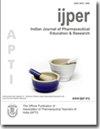Stability-Indicating Reversed Phase-HPLC Method Development and Validation for Estimation of Phenylephrine in Bulk and Tablet
IF 0.8
4区 医学
Q3 EDUCATION, SCIENTIFIC DISCIPLINES
Indian Journal of Pharmaceutical Education and Research
Pub Date : 2023-08-23
DOI:10.5530/ijper.57.3s.90
引用次数: 0
Abstract
Background: This study is aimed to develop a validated stability-indicating method of a nasal decongestant phenylephrine hydrochloride in bulk and tablet. Materials and Methods: A sensitive, accurate, and specific reversed-phase stability indicating HPLC method was developed and validated by following ICH guidelines, for the estimation of Phenylephrine Hydrochloride (PHE) in bulk and tablet. On Luna® 5µm C 18 column (250 × 4.6mm), the isocratic separation was achieved using mobile phase of 5mM ammonium acetate (pH 4.7): methanol (80:20; v/v) with a flow rate of 1 mL/min and a column temperature at 30°C. The proposed method was able to produce good separation of the drug and its degradation products with sharp peaks. The quantification was done at 272 nm by photodiode array detection. Conclusion: It was discovered that the phenylephrine hydrochloride was resilient to photolytic and thermal degradation, but degraded under acid, base, and oxidative stress conditions. The developed method was found to be linear, robust, and accurate and can be successfully applied for identification, quantitative determination, and monitoring of the stability of phenylephrine in bulk and tablet dosage forms.稳定性指示反相高效液相色谱法测定原料药和片剂中苯肾上腺素的方法开发与验证
背景:本研究旨在开发一种经验证的鼻腔减充血剂盐酸苯肾上腺素散装和片剂的稳定性指示方法。材料和方法:根据ICH指南,建立并验证了一种灵敏、准确、特异的反相稳定性指示HPLC方法,用于测定散装和片剂中盐酸苯肾上腺素(PHE)的含量。在Luna®5µm C18柱(250×4.6mm)上,使用5mM乙酸铵(pH 4.7):甲醇(80:20;v/v)的流动相实现等度分离,流速为1mL/min,柱温为30°C。所提出的方法能够很好地分离药物及其降解产物,并具有尖锐的峰。通过光电二极管阵列检测在272nm处进行定量。结论:盐酸苯肾上腺素具有较强的光降解和热降解能力,但在酸、碱和氧化应激条件下均能降解。所开发的方法线性、稳健、准确,可成功应用于散装和片剂中对苯肾上腺素稳定性的鉴定、定量测定和监测。
本文章由计算机程序翻译,如有差异,请以英文原文为准。
求助全文
约1分钟内获得全文
求助全文
来源期刊
CiteScore
1.40
自引率
0.00%
发文量
227
审稿时长
>12 weeks
期刊介绍:
The official journal of Association of Pharmaceutical Teachers of India (APTI) and is being published since 1967. IJPER, a quarterly publication devoted to publish reviews and research articles in pharmacy and the related disciplines of Pharmaceutical education. It mainly covers the articles of special interest, covering the areas of Pharmaceutical research, teaching and learning, laboratory innovations, education technology, curriculum design, examination reforms, training and other related issues. It encourages debates and discussions on the issues of vital importance to Pharmaceutical education and research. The goal of the journal is to provide the quality publications and publish most important research and review articles in the field of drug development and pharmaceutical education. It is circulated and referred by more than 6000 teachers, 40,000 students and over 1000 professionals working in Pharmaceutical industries, Regulatory departments, hospitals etc.

 求助内容:
求助内容: 应助结果提醒方式:
应助结果提醒方式:


